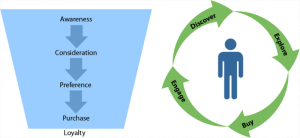I am a firm believer in lifecycle marketing. Thinking of the entire lifespan of your customer challenges you to revisit your brand strategy and build more robust marketing tactics that extend beyond merely transactional touch-points and improve overall user experience.
But recently Performable, a web marketing tool provider, has made an interesting claim: “The Funnel is Wrong”. On his Forrester blog, Steven Noble goes as far as to say that we should bury the conversion funnel altogether.
The Performable whitepaper says there are a lot of things wrong with funnel marketing, but the bottom line is: funnel marketing doesn’t reflect customer behavior, tends to separate marketers from customers, doesn’t provide enough context for the user experience and doesn’t account for a particular phase in the customer lifecycle. The outcome of the funnel is a simplistic approach to optimizing web marketing efforts that is not nearly as holistic or effective in the short-term or long-term as lifecycle marketing. Read whitepaper: Why Lifecycle Marketing is the Future
Here’s how Steven Noble illustrates the comparison between the funnel and lifecycle frameworks:

You get the basic idea – one depicts a linear path that assumes each transaction results in increased loyalty. The second involves a variety of experiences with a brand that gradually and cumulatively drive not only more future transactions, but a personal loyalty to the brand.
Apples to Oranges
First of all, I am not sure how funnel marketing is opposed or even comparable to lifecycle marketing. From my experience, funnel marketing is a tactic that can easily be crafted to fit within a lifecycle marketing strategy. There might be plenty of ways to terribly execute a funnel marketing plan and to execute such a plan without any consideration of strategy, but that doesn’t at all indict funnel marketing per se.
Comparing lifecycle marketing and funnel marketing is like comparing Hitler’s strategy for dominating all of Europe with General MacArthur’s island-hopping tactics at Okinawa. It’s just not comparing apples to apples.
Evaluated as a strategy, funnel marketing would look pretty ridiculous. But that is because it isn’t a strategy at all! It’s really easy to shoot down the weaknesses of a funnel-based approach if you’re thinking of it as a strategy.
An Officer, Not a General
Yes, conversion funnels (on their own) are wooden, overly linear, too focused on transactions and don’t account for the variety and depth of user experiences. But has anyone said funnels were supposed to more than this? Perhaps someone has said it, but I don’t know of a single reference to funnel marketing as a comprehensive online marketing strategy.
In any case, I do think Performable could make a point. It seems like the real enemy isn’t the activity of funnel marketing, it’s narrow-mindedness that focuses merely on transactional conversions, without the broader context of a lifecycle strategy to inform other critical touchpoints and non-transactional conversions/actions that are needed to cultivate a long-term relationship with customers.
KPIs and conversion funnels are narrow-minded on purpose – they have to be in order to make sense of data and adjust quickly. But web analysts, good ones anyhow, know that the KPIs aren’t a substitute for an over-arching strategy.
You don’t let an officer direct an entire military force, but you still need him. Understand his role, and he could be the difference between success and failure.
There is Still a Heartbeat
There are good reasons not to bury the conversion funnel. In the web intelligence/analytics community there is a strong emphasis on tracking KPIs at the end of funnels, and I think this is crucial for a few reasons:
- They’re quantitative
- They’re based on business outcomes
- They provide a focused and simplified view of web performance that enables quick analysis and action
#3 is important because of a few huge problems with how web analysis has been done historically: Too much data, too many reports, tons of data that may be interesting but only 1% or less that is relevant or actionable.
Funnel to Freedom
So even if I sometimes get trapped in my conversion funnels, I force myself to periodically take a step back, look at the strategy, and make sense of the data within that high-level context. Ideally, that strategy includes the customer lifecycle. This is not only good common sense, but it is also psychologically refreshing for marketers like myself who thrive off of a sense of the big picture and how the end-user is actually benefiting.
Looking at data through the lens of the overall strategy means, of course, that my conversion funnel data should include conversions that are not just transactional, but also track other key interactions in the customer lifecycle, like survey completions, social media mentions, product recommendations, “share with a friend” actions, etc. In other words, my conversion funnel data can and should provide me with insights about the overall health of my customer lifecyle. If I haven’t defined my KPIs around a unified strategy, how will they be of any use to me? In this respect, I disagree with the criticism that funnels can’t tell us about actual customer behavior or experience.
A Modest Proposal
I think Performable’s message needs qualification: funnel marketing is only wrong when employed without a strategy, which lifecycle marketing can provide.
As a web analyst, I know how incredibly easy it can be to get buried in the numbers and fixate on conversion funnels. But I can’t throw the baby out with the bath water, or bury the baby with the bathwater…. hmmm, my imagery is becoming problematic.
There is a place for funnel marketing within customer lifecyle marketing. If you see yourself letting the funnel become the be-all end all, pull yourself out and revisit your customer lifecycle strategy. Whatever you do, don’t pull the plug.
But that’s just my take at the moment.
Do you think there’s hope for funnel marketing or AIDA related models?
If you have a moment, make sure to check out Performable’s software. It is quite innovative and ambitious in its attempt to gauge customer lifecycle performance. I haven’t seen a demo yet, but the concept is certainly intriguing.

